14 Most Common Types of Butterflies in South Carolina (With Pictures)
-
Pete Ortiz
- Last updated:

Approximately 165 butterfly species call South Carolina home for at least part of the year, offering residents a world of wondrous natural displays. With gorgeous symmetrical patterns brought to life via vivid colors, butterflies bring a new level of beauty to outdoor areas. Discover what kind of sights are in store for you with this look at some of the most common types of butterflies in South Carolina.
The 14 Common Types of Butterflies in South Carolina
1. Eastern Tiger Swallowtail

| Scientific Name | Papilio glaucus |
| Wingspan | 3.5–5.5 inches |
The non-migratory Eastern Tiger Swallowtail is one of the most identifiable butterflies in South Carolina. The state adopted the Eastern Tiger Swallowtail as its official symbol in 1994, a fitting title for a large and vibrantly colored specimen that is all too eager to grace gardens and backyards with its presence.
Males have striking yellow wings with black “tiger” stripes. Females either have yellow wings with sharper black margins or completely black wings with light blue speckling on the lower portions. In nature, you’ll find it in moist forested areas enjoying nectar from wild cherry, lilac, milkweed, coneflowers, and other tall-stalked flowering plants.
2. Eastern Tailed-Blue

| Scientific Name | Cupido comyntas |
| Wingspan | 0.75–1.0 inches |
The Eastern Tailed-Blue may be tiny, but it’s hard not to fall in awe of the male butterfly’s iridescent blue wings highlighted further by a dark border and contrasting bright white edge. Females have more subdued dark gray wings that feature a similar white margin. The wings of both sexes have light gray undersides and distinct orange marks above each wing’s tail.
As a low flier, the Eastern Tailed-Blue prefers meadows, disturbed sites, and other relatively open areas where it can find low-sitting flowers such as sweet clover, asters, and wintercress. Host plants include several legumes in the pea family, including clover, trefoil, and alfalfa.
3. Spicebush Swallowtail

| Scientific Name | Papilio troilus |
| Wingspan | 3.0–4.0 inches |
The Spicebush Swallowtail is similar to the Eastern Tiger Swallowtail in several ways. Mature caterpillars have a striking appearance, featuring an enlarged head and eyespots that can make them look like snakes to predators. And as butterflies, they imitate their more toxic cousin, the Pipevine Swallowtail, much like the black-winged female Eastern Tiger.
Spicebush Swallowtails reside across South Carolina, with habitats ranging from deciduous woodlands and swamps to open fields and urban backyards. As the name implies, spicebush is an essential draw for these attractive butterflies. Other host plants include sassafras and sweet bay, while some of their favorite food sources include azaleas, jewelweed, and Japanese honeysuckles.
4. Red-Banded Hairstreak

| Scientific Name | Calycopis cecrops |
| Wingspan | 0.75–1.25 inches |
The Red-Banded Hairstreak is one of the smaller South Carolina butterflies and is an attractive species living around dry wooded regions in rural and urban areas. Its tiny gray wings feature a vibrant band of orange and include two tails on each as part of a defense mechanism. You can find the Red-Banded Hairstreak flying around forest edges, clearings, and coastal hammocks.
Caterpillars emerge under the fallen leaves of host plants, such as wax myrtles, sumacs, and oak trees. Along with these trees, plants like milkweed, meadowsweet, sweet pepperbush, and yarrow will attract adults during the active summer season.
5. Gulf Fritillary
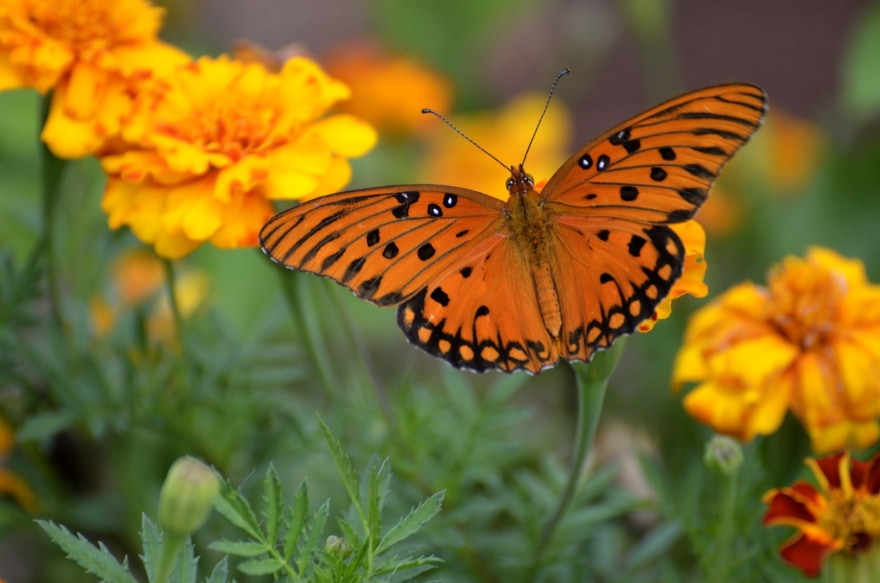
| Scientific Name | Agraulis vanillae |
| Wingspan | 2.5–3.75 inches |
The Gulf Fritillary is a semi-migratory butterfly that prefers warmer locales, with a range rarely reaching into northern states. It can be a common sight year-round in South Carolina, where mild weather lets it overwinter. They’re easy to attract to flower gardens in rural and urban environments.
Passionflower vines are the host plant for Gulf Fritillary larvae, which are distinguishable by their bright orange bodies and sharp black spines. You can find these butterflies across South Carolina next to roadsides and in open areas like fields, pastures, and parks. You can differentiate the Gulf Fritillary from the similar Monarch butterfly by the silver spots on the underside of its black-speckled orange wings.
6. Carolina Satyr

| Scientific Name | Hermeuptychia sosybius |
| Wingspan | 1.25–1.5 inches |
The relatively discrete Carolina Satyr is a small butterfly you’ll usually find flying around grasslands and forest understories. Although the brown backs of the wings aren’t particularly interesting, the butterfly often rests with them perked upright to show off the distinguishing lines of eyespots near the edges.
Carolina Satyrs lay their eggs in a variety of grasses common to lawns. While they eat nectar occasionally in the fall, adults typically feed on tree sap, rotting fruit, and fungi, much like other satyrs.
7. Monarch

| Scientific Name | Danaus plexippus |
| Wingspan | 3.5–4 inches |
The black-veined orange wings of the Monarch butterfly are some of the most recognizable in South Carolina and beyond. The unique migrations of hundreds of butterflies are sights to behold as they journey from Mexico to southern Canada and back again with the changing seasons.
Sadly, Monarch populations faced severe losses over the last several decades, with western populations declining by 99.9%. Eastern populations that touch South Carolina are also in rapid decline. Homeowners can do their part to help Monarchs and other essential pollinators by adding their favorite plants to the garden.
Monarchs depend on milkweed as a host plant and a nectar source at all times of the year. In South Carolina, they’ll also dine on goldenrods, ironweed, and tickseed when they pass through the state in the fall. During the spring migration, they’ll opt for red clover, lantana, thistles, and lilac.
8. Cloudless Sulphur
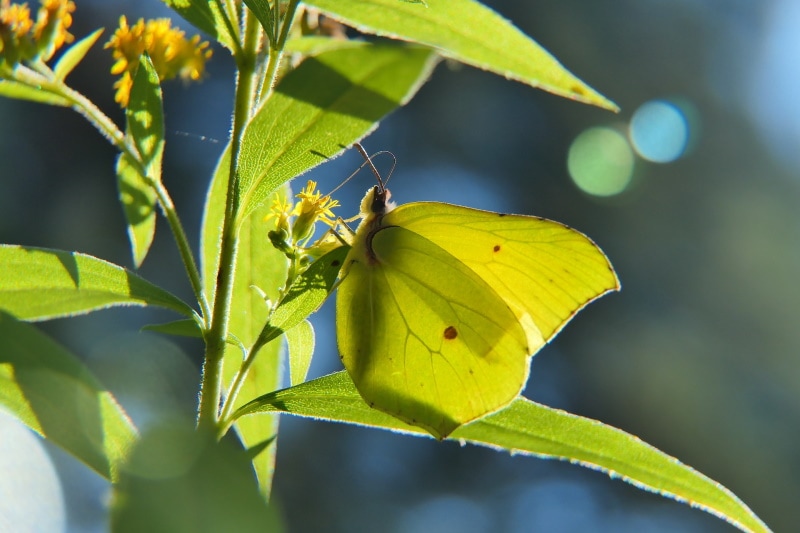
| Scientific Name | Phoebis sennae |
| Wingspan | 2.25–3 inches |
The lemon-colored wings of the Cloudless Sulphur are as bright and sunny as the open fields, yards, road edges, and beaches where these South Carolina butterflies live. As the largest and one of the most abundant types of sulphur species, they are easy to find across the state and not timid about hanging around humans. Fall migrations of Cloudless Sulphurs are easy to view in South Carolina as they fly close to the ground.
Plant hosts consist of several species of Cassia and Senna in the pea family. As for nectar, Cloudless Sulphurs look to various long-tubed flowers such as hibiscus, lantana, and wild morning glory.
9. Cabbage White

| Scientific Name | Pieris rapae |
| Wingspan | 1.75–2.25 inches |
Cabbage whites may be familiar in South Carolina, especially in open, populated areas, but they’re far from desirable. The larvae are garden pests, munching on leafy veggies in the mustard family, such as kale, cabbage, and cauliflower. Keep an eye out for green caterpillars with a thin yellow stripe.
The adult form of this invasive species features delicate paper-white wings with light green undersides. You’ll rarely want to attract it to your yard, but you can do so with dandelions, asters, mints, and mustard plants.
10. Clouded Skipper

| Scientific Name | Lerema accius |
| Wingspan | 1.25–1.75 inches |
Clouded Skippers stay low-key with their dark brown wings, but shades of shimmery violet on the undersides add a touch of flash. They’re common in grassy areas in South Carolina, such as meadows, forest edges, and woodland clearings near rivers and swamps.
Caterpillars live in grasses, particularly St. Augustine and wooly beard grass. Adults feed on a broad assortment of flowers, including lantana, buttonbush, and shepherd’s needle.
11. Variegated Fritillary
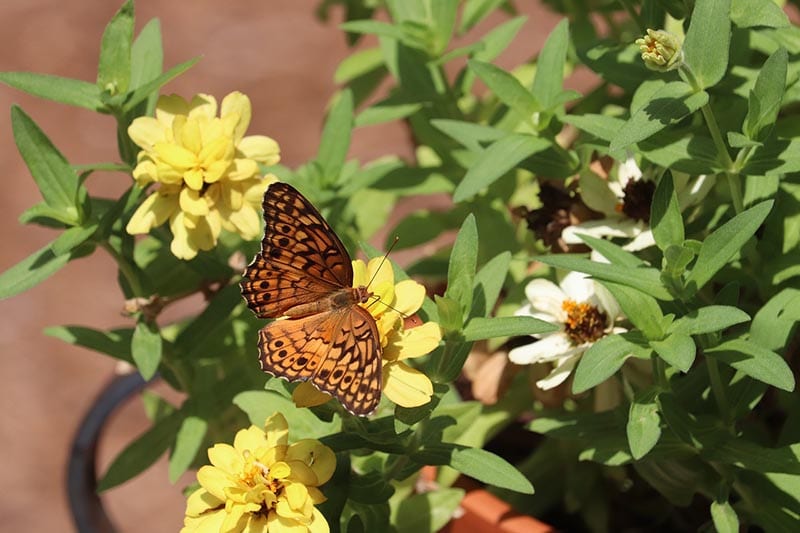
| Scientific Name | Euptoieta claudia |
| Wingspan | 1.75–2.5 inches |
The Variegated Fritillary butterfly’s complex wing patterns add loads of intrigue to the various brown and orange shades. Thick veins create a wavy gridlike pattern along the topside, while black spots line the edge. While the adult butterfly is attractive, the Variegated Fritillary distinguishes itself via its mesmerizing pearly chrysalis.
You can find these butterflies in the open, residing around prairies, fields, and roadsides. Like the Gulf Fritillary, the Variegated species seek out passionflower plants as host plants but will also use ornamentals like violets and stonecrop. Mature butterflies enjoy red clover, peppermint, dogbane, and various types of milkweed.
12. Red-Spotted Purple
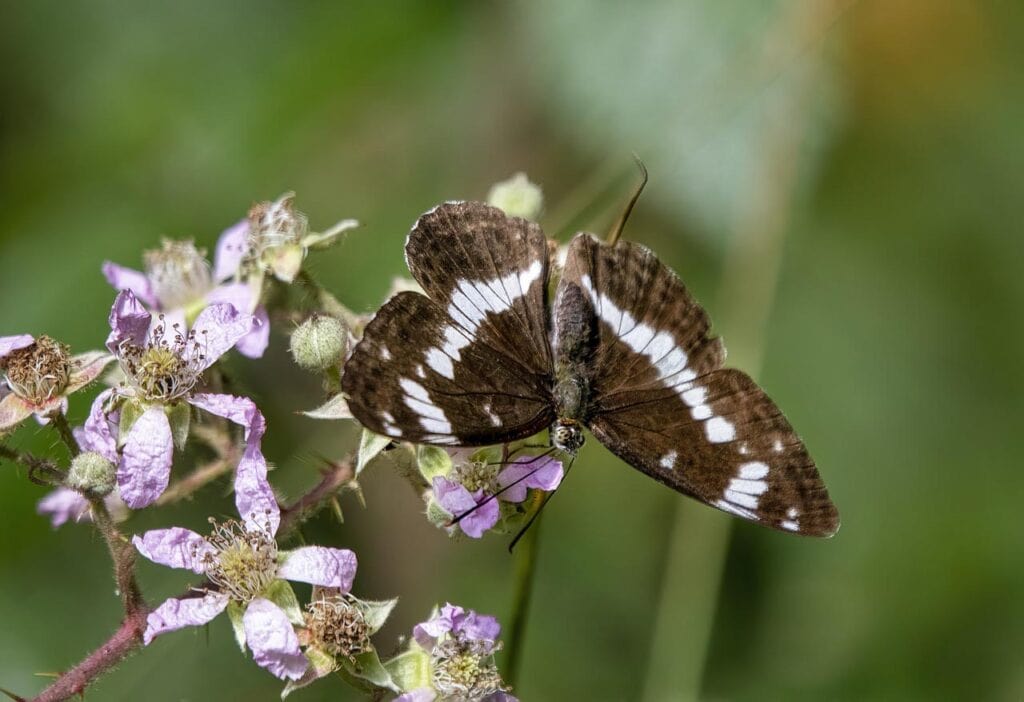
| Scientific Name | Limenitis arthemis |
| Wingspan | 3.0–4.0 inches |
With shiny blue wings accentuated by contrasting orange spotting, the Red-Spotted Purple is a visual treat and arguably the most beautiful butterfly in South Carolina. Interestingly, the butterfly is one of two members of the same species. The Red-Spotted Purple’s body mimics the local poisonous Pipevine Swallowtail, while its northern counterpart, the White Admiral, has black wings with thick white bands.
Red-Spotted Purples use various trees and shrubs as host plants, including wild cherry, poplar, oak, birch, hawthorn, and willow. Adults prefer tree sap, rotting fruit, dung, and carrion but will occasionally enjoy nectar from asters, goldenrod, and other flowers. Putting cut-up oranges and other fruit in a suet feeder is an excellent way to attract them in the summer.
13. American Lady
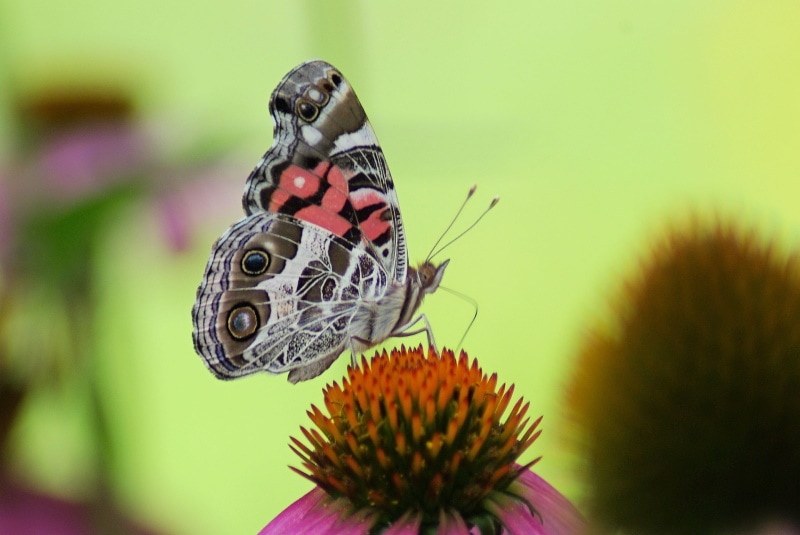
| Scientific Name | Vanessa virginiensis |
| Wingspan | 1.75–2.5 inches |
American Lady butterflies have attractive orange-brown wings with dark borders and distinct white and purple spots along the margins. But even more appealing are the undersides, featuring complex cobweb markings and large eyespots for repelling predators. Summer adult forms are more vibrant than the smaller late-season forms.
Hilltops and wide-open areas with low-lying plants are the best places to find American Lady butterflies in South Carolina. Caterpillars create conspicuous silky nests on host plants such as cudweed, pearly everlasting, wormwood, and other weeds. Adults enjoy popular butterfly-attracting flowers, including milkweed, asters, goldenrod, and dogbane.
14. Common Buckeye

| Scientific Name | Junonia coenia |
| Wingspan | 1.75–2.75 inches |
The pronounced eyespots on the Common Buckeye’s brown wings make a spectacular sight if you can get close enough to see their varying hues. These attractive South Carolina residents stay relatively exposed in sunny areas with low-growing vegetation but are quick to fly away at the first hint of danger.
Adult Buckeyes will lay their eggs on herbaceous plants, such as snapdragons, foxglove, toadflax, and plantain. They feed on numerous plants, including asters, dogbane, gumweed, and peppermint, but will drink from puddles and mud on the ground where they hang out.
Final Thoughts
Butterflies of all kinds love South Carolina’s near-perfect climate as much as the people who live there, which is great news for Palmetto State residents. By staying aware of the common types of butterflies in South Carolina, you can plan your landscaping to bring these stunning creatures in droves.
Featured Image Credit: 4Me2Design, Pixabay
Contents



